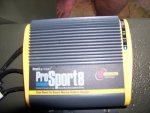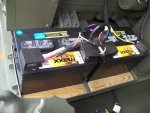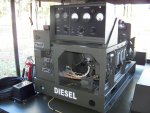1800 Diesel
Member
- 768
- 25
- 18
- Location
- Santa Rosa County, FL
Ok I did a few searches on the forum but couldn't find much discussion other than solargizer usage. Either I'm not good at using the search feature or there's just no material posted.
I've got two MEP2s that are showing no-charge readings while running. I plan to go through the "Speddmon checklist" on both of them but in the event the stator is found to be defective I am working up a "Plan B" 24V charger installation, complete with a on/off switch, circuit breaker (for the AC side) & a charger on indicator light. An option could also be to install an actual voltmeter showing voltage reading, though this would be redundant since the unit already has the on-board gauge showing the "red" or "green" battery charging condition.
Things to consider:
1) Where to tap in to get the 120VAC? My first thought, piggyback on the same line that feeds the convenience outlet fuse, though on the "un-fused" side so this new circuit doesn't affect the 15-amp breaker load.
2) Where to install the charger? Possibly underneath the control cubicle on one the frame components and on small shock isolators.
3) Where to install the breaker, switch & indicator light. Thinking here to go into the control box. It's tight in there but there's enough real estate for these components and this location would minimize AC wiring lengths.
4) DC wiring would simply ride the existing harness to the battery & starter area.
5) Per TM, the on-board system puts out 6.5-10 amps & the unit I'm looking at puts out 5 amps. The unit being worked will be used on my brother's remote acreage (no grid power available) to run an irrigation pump and some lighting and it will also have a solar charger to maintain the batteries.
So has anyone already done something like this?
Will the 5 amp rate be enough? Are there any other DC loads besides charging the batteries? The charger I'm looking at has three levels: full charge rate, maintain rate & a float charger rate.
If anyone has a comment (pro or con) with my plan please weigh in.
As a footnote, I would normally do a repair on the on-board system, but this is the same unit that I was unable to pull the blower wheel, hence the Plan B consideration. Don't want to send my brother a unit that can't charge the batteries...especially since it'll be at a remote site...
Thanks.
I've got two MEP2s that are showing no-charge readings while running. I plan to go through the "Speddmon checklist" on both of them but in the event the stator is found to be defective I am working up a "Plan B" 24V charger installation, complete with a on/off switch, circuit breaker (for the AC side) & a charger on indicator light. An option could also be to install an actual voltmeter showing voltage reading, though this would be redundant since the unit already has the on-board gauge showing the "red" or "green" battery charging condition.
Things to consider:
1) Where to tap in to get the 120VAC? My first thought, piggyback on the same line that feeds the convenience outlet fuse, though on the "un-fused" side so this new circuit doesn't affect the 15-amp breaker load.
2) Where to install the charger? Possibly underneath the control cubicle on one the frame components and on small shock isolators.
3) Where to install the breaker, switch & indicator light. Thinking here to go into the control box. It's tight in there but there's enough real estate for these components and this location would minimize AC wiring lengths.
4) DC wiring would simply ride the existing harness to the battery & starter area.
5) Per TM, the on-board system puts out 6.5-10 amps & the unit I'm looking at puts out 5 amps. The unit being worked will be used on my brother's remote acreage (no grid power available) to run an irrigation pump and some lighting and it will also have a solar charger to maintain the batteries.
So has anyone already done something like this?
Will the 5 amp rate be enough? Are there any other DC loads besides charging the batteries? The charger I'm looking at has three levels: full charge rate, maintain rate & a float charger rate.
If anyone has a comment (pro or con) with my plan please weigh in.
As a footnote, I would normally do a repair on the on-board system, but this is the same unit that I was unable to pull the blower wheel, hence the Plan B consideration. Don't want to send my brother a unit that can't charge the batteries...especially since it'll be at a remote site...
Thanks.
Last edited:







